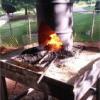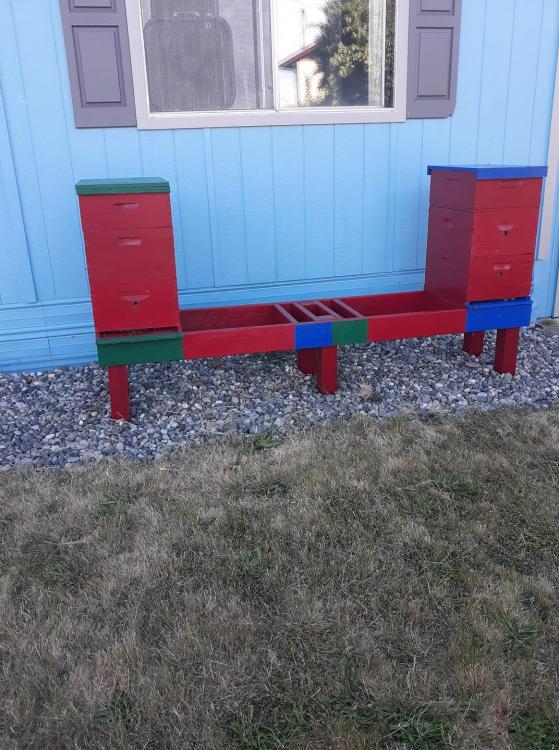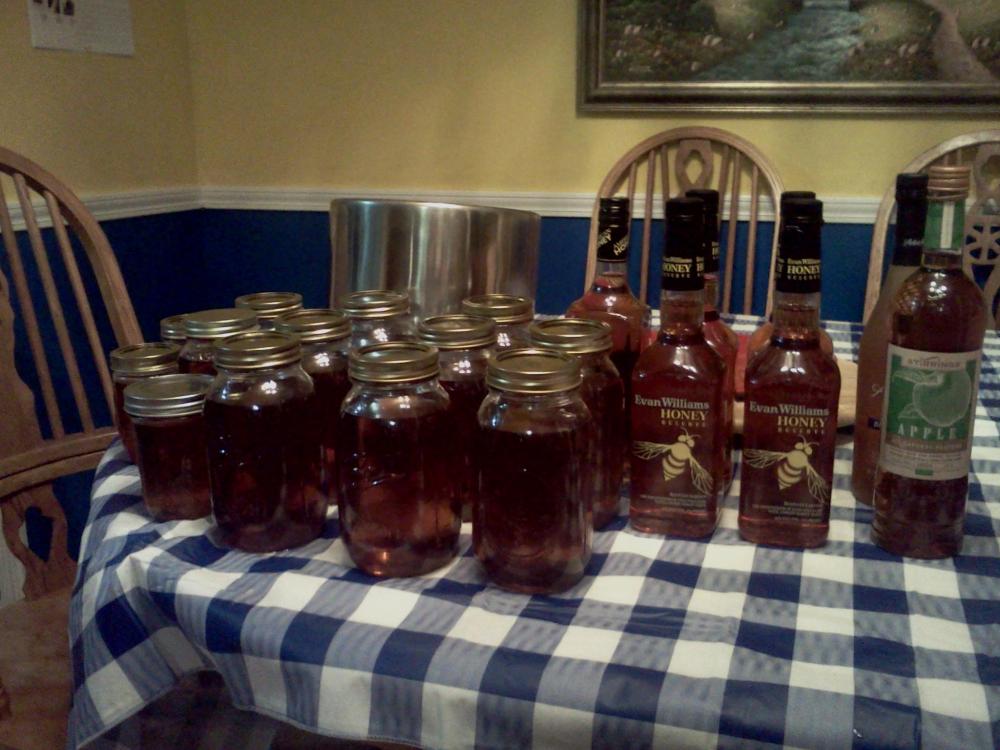-
Posts
1,602 -
Joined
-
Last visited
Content Type
Profiles
Forums
Articles
Gallery
Downloads
Events
Everything posted by Nobody Special
-

Graphite/Beeswax Punching Lube
Nobody Special replied to GeologicalBlacksmith's topic in Alchemy and Formulas
Fire works. But have you ever smelt it burning? Eww..... -

Graphite/Beeswax Punching Lube
Nobody Special replied to GeologicalBlacksmith's topic in Alchemy and Formulas
Lot's of bleach will get the maggot smell out, for rot, it takes an mild acid, or for fat...man this got gross, for fat that's turned, it needs an alkaline. Don't ask me how I know. -

Graphite/Beeswax Punching Lube
Nobody Special replied to GeologicalBlacksmith's topic in Alchemy and Formulas
Still doesn't smell as bad as cutting bone with a power saw or a cutting disc. -

Making Nordic Gold without boiling off all my zinc
Nobody Special replied to MageDK's topic in Copper Alloys
There's several things to consider. You need to allow for zinc loss before adding it. Done right, you shouldn't lose more than about five percent. You don't want the copper heated beyond the boiling point, then add solid zinc at the last minute. You may also want to cool your alloy right after dissolving the zinc, and are you using flux? A heavy layer of flux on the surface will keep more zinc in the mix, especially since it's harder for it to burn without oxygen. I don't know your experience level in casting, but you're taking precautions working with molten zinc, right? Zinc gasses do incredibly nasty things to the respiratory system, and I wouldn't give fume fever to my worst enemy. It's just Aluminum brass, Frosty, they went to using it in coins after they had so many issues with Aluminum bronze tarnishing. -

Kanca vs Holland vs Hoffman
Nobody Special replied to stringstalker82's topic in Anvil Reviews by brand
Kanka actually says on their website that undesignated parts of their anvils may be soft, with a hardness of 30-40 hrc. Love the look of the hollands and Jymm Hoffman's double horn colonial. I now know what I want for Christmas. -
Good morning, I've read that about oroshigane, in the far reaches of the internet, along with intense debate over whether it was tamahagane, or tamahagane including scrap, or any scrap billet made by the smith. Definitely internet fodder though, the Japanese swordmaking section of my library is a bit scarce, although I recently obtained Mark Kulansky's microhistory of paper, the Beekeper's Bible, and several books on the OMC stern drive they were putting in Bayliners in the early 80s. My love of obscure, or at least not mainstream texts runs in the wrong direction, I suppose. I confess, I completely miss the 38 reference, unless it's the sum of the square of the first three primes, number of slots on a roulette table, or the caliber of a Saturday night special. Definitely Mister, btw. I would probably actually read that, although the only thing I remember about Taprobane is that it was Sri Lanka, I think? I went through a Greek history phase while I was in Iraq. I remember reading about wind powered bloomeries, and copper furnaces elsewhere, and I would love to try the smelting furnace, but I only have scrap here, no ore and don't have the advantage of building on a hill (I'm on the water) to catch prevailing winds. I also have a small lagoon handy to the property that would be fun to play with, but I think the bloody homeowner's association would flip over a tidal mill. This the article? Juleff, G. An ancient wind-powered iron smelting technology in Sri Lanka. Nature 379, 60–63 (1996). https://doi.org/10.1038/379060a0.
-
For casting and for what smelting I've done, I've mostly preferred charcoal. If I remember correctly, (a definite maybe), orishigane was steel put together by Japanese smiths from selected pieces of tamahagane iron blooms (a famous steel made from Japanese iron sands in a complex three day process). Sometimes they added other bits of steel to lower the iron content. Tamahagane was the starting point for katanas, orishigane was the end steel for katanas, welded into a billet. Mr. Powers has an intimate knowledge of metallurgy, and will assuredly know what I have messed up above. From my experience, he will also be able to recommend three amazing books, which will only have four copies each in existence, one of which will be his, and one copy of the rest you will be able to get from your local library through a lending exchange program. I highly agree that you will want different setups for different ores. You will also almost certainly want different setups for casting than from smelting. Freshly smelted metals often take a good deal of cleanup or refining, and many behave differently from each other, depending on the other compounds they contain. (This is also true for casting from ingots made from scrap metal). Both casting and smelting can be incredibly dangerous and have steep learning curves. If you have questions, I would recommend hunting down or joining a group or finding someone that does casting near you and taking a class, or seeking mentorship. It may help you avoid fume fever, or some of the funny looking scars that I got trying to teach myself. At least it's been enough years that you have to know where the white dots are on my legs, crucible failure suuuuuuuucks and should be planned for). Or there was the time that I spilled flux and accidentally created a small limelight. My wife thought that the sunburn was hilarious though. Mind you I'm not saying don't do casting, just that you will have a much safer, more successful time if you seek help.
-
Hard to go wrong with Coq au vin. The Coq is optional, the vin is not.
-
Africanized bees, yellow jackets, murder hornets. We've got all of it...especially dang varroa mites. Youse guys have inspired me. Gonna go work on the 74 Dart. Swapping a leaky fuel sending unit.
-
Me to Self: I'm finally immune to beestings again, I barely even feel them. Bees to Self this morning when I was covering the hives which were being robbed: The moron thinks he's tough now. Good morning earlobes.
-
Shoot, that's your parts car? Reminds me of my dad's 60 El Camino. He bought a second one for a parts car in the 90s, and ended up using it as a daily driver.
-
I don't have a lot to add to what's above. The main mechanical benefit that you surrender if not tempered, is that if you've hardened it properly, or even improperly, you are at serious risk of the edge chipping or the knife breaking. They sometimes even break on their own with no use if you don't temper after hardening. This can be especially dangerous in a kitchen knife.
-
On the vehicle side, I'm playing with a 74 Dodge Dart I picked up for a song, and a xxxxxx stern drive Bayliner. I'd be fine with the Bayliner becoming an artificial reef, but I like the Dart. Did the head gaskets and freeze plugs, raised the dang torque bars to where it didn't scrape the wheel wells when you make a turn, and we're currently playing with the carburetor and getting rid of all the assorted duct tape and bubble gum from the previous owner. This is far more literal than I would have believed possible. The vacuum hose is connected to the brake booster with silicon caulk. Funny things, intake and exhaust bolts work better when they're not just hand tight.
-
Ain't PTSD fun? I self-medicate for it on occasion. One of the reasons I make mead, although corn whiskey does nicely too. Doesn't fix the insomnia, but it moves it around a bit. Bees see color, and they orient visually. That's why on a sunny afternoon you'll see dozens hanging out hovering in front of the hive. They're new bees orienting so they can find their way home when they forage. In America hives are traditionally white or light tan for temperature control, and also because it's cheap and easy to spot in a field. In other parts of the world, they paint them all kinds of colors, and that's also more common with hobbiests. Up here it rarely gets much above 70, so I don't have to worry about overheating, and they stay warmer in the cool months. You also get less drift (bees going in the wrong hive) when the hives are close together if the patterns and colors are different. Also, it's pretty. You wouldn't believe some of the crazy hives out there. There's at least one top bar hive I saw with a bed and cover built on top. You sleep on top of the bees.
-
You mention the Rose of Lancaster, and now you've got me thinking of the Mel Brooks joke about the War of the Roses being the only just war. "One day we woke up, and all our roses were gone. Hey, where's my roses, you ain't gonna get my roses, mister." Here's a pic of the hive stand I made this weekend, with the new hive (blue top) we picked up Friday cleaned up, painted, and with a new bottom board and a super added.
-
I occasionally see some evidence, sir, to the contrary. Mr. Welsh, So pink.....so very, very pink... I welcome pics, btw. Think of it as a "what did you do outside the shop today?" post. Here's an old one from making mead.
-
Afternoon all, First of all, this isn't a post directly about blacksmithing, which is kind of the point. I was planning to go pick up another beehive today, and started thinking about all the nutballs and weirdo....I mean, wonderfully eclectic people I run into in this hobby, and that a large number of them have other hobbies that are a bit outside the mainstream. The more obvious trends I see are of course cooks, hunting, fishing, readers, musicians, and brewers galore (although sometimes some very eclectic music), and almost anything homestead related. On the other hand, I've met guys that build cob houses, sculptors, musical instrument builders, linguists, one guy that built robots. So what else do you guys do? What other weird talents do you have in your skill set? I keep bees and chickens, do casting on occasion, and *gasp* I've been known to knit or work a crossstitch needle. I also like messing with random historical tidbits and recreations. Trebuchets one month, making garum the next, after that, who knows?
-

Old anvil of somewhat unusual form
Nobody Special replied to MilwaukeeJon's topic in Anvils, Swage Blocks, and Mandrels
Good evening, there's always the classic, chisel out a coyote sillhouette and curl the end poking out. And I believe what you all are looking for, naturally, is duck tape. Possibly in 8-track. -

I got lucky with this Anvil!
Nobody Special replied to Scooter430's topic in Anvils, Swage Blocks, and Mandrels
Buy the fellow that gave that to you a case or three of beer. You got a thousand bucks worth of anvil for free. And don't listen to them, buy a scratch off now before the streak ends. -

Video: Van Der Steeg forges an anchor
Nobody Special replied to Latticino's topic in Blacksmithing, General Discussion
Don't sir me, I are a crusty old NCO. 1999 to present, Currently S-2, HHC, 56th TIOG, Washington NG, M-day status only. Got 15 yrs of full-time and don't need the stress anymore. Did a few years at Hood and had buddies in 4 ID. -

Video: Van Der Steeg forges an anchor
Nobody Special replied to Latticino's topic in Blacksmithing, General Discussion
Lasts forever in marine environments too, way better than galvy. I'm on an island here, and it never fails to amaze me how many wrought iron chains and anchors are sitting out as yard art. Also, a perfectly good post vise just up the road from me holding up a yard sign. Sigh... sometimes it sucks not being a kleptomaniac... BTW Welshj, ya've got four lieutenants pointing north on your avatar. -

Mystery stuff is always free and easy
Nobody Special replied to rockstar.esq's topic in The Business Side of Blacksmithing
I could argue that it delayed service, although it's likely to be outweighed by COVID delays, but I would also say that failure to state the charge is fairly prejudicial. How do you prepare for a trial or discovery if they've failed to say what they're taking you to court for? At any rate, I don't lose anything by making the motion, and I might gain something. If it gets tossed here, their only recourse is to go to the superior court, and up here they often refuse the case out of hand if the lower court kicked it back. Also, the plaintiff is being a...umm...fourth point of contact, and I want to irritate them and point out that they don't have their act together before we discuss that two-thirds of their move out charges are illegal under state code. The legal ones are maybe a third of the deposit, and I offered repeatedly to let them keep the whole thing. Hopefully they get tired of it before mandatory arbitration. I hate arbitration.


